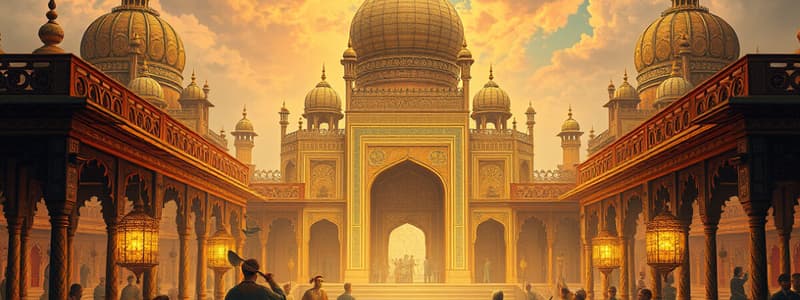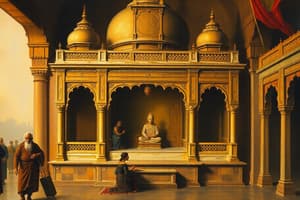Podcast
Questions and Answers
Who established the independent kingdom of Mysore in the 18th century?
Who established the independent kingdom of Mysore in the 18th century?
Chikka Krishna Raj established the independent kingdom of Mysore.
What significant military conflict did Hyder Ali win against the British?
What significant military conflict did Hyder Ali win against the British?
Hyder Ali won the First Anglo-Mysore War in 1769.
What title was given to Tipu Sultan, and why?
What title was given to Tipu Sultan, and why?
Tipu Sultan was called the 'Tiger of Mysore' for his fierce resistance against the British.
What inspired Shivaji Maharaj to seek freedom for the Maratha people?
What inspired Shivaji Maharaj to seek freedom for the Maratha people?
Who was the first Peshwa and what role did he play in the Maratha empire?
Who was the first Peshwa and what role did he play in the Maratha empire?
What happened at the Third Battle of Panipat in 1761?
What happened at the Third Battle of Panipat in 1761?
What was the significance of the treaty signed by the Marathas with the Mughal emperor in 1751?
What was the significance of the treaty signed by the Marathas with the Mughal emperor in 1751?
Describe Shivaji's escape from imprisonment in Agra.
Describe Shivaji's escape from imprisonment in Agra.
Which region did Shivaji's kingdom encompass by the time of his death in 1680?
Which region did Shivaji's kingdom encompass by the time of his death in 1680?
Who were the main adversaries of Hyder Ali during his rule?
Who were the main adversaries of Hyder Ali during his rule?
What major invasions weakened the Mughal Empire in the 18th century?
What major invasions weakened the Mughal Empire in the 18th century?
What were the jagirdari and mansabdari systems implemented by Akbar?
What were the jagirdari and mansabdari systems implemented by Akbar?
How did the foreign powers contribute to the decline of the Mughal Empire?
How did the foreign powers contribute to the decline of the Mughal Empire?
Who established the semi-independent kingdom of Hyderabad, and what was his title?
Who established the semi-independent kingdom of Hyderabad, and what was his title?
What was the significance of Lucknow during the rule of the Nawabs of Awadh?
What was the significance of Lucknow during the rule of the Nawabs of Awadh?
What did Murshid Quli Khan achieve as the governor of Bengal?
What did Murshid Quli Khan achieve as the governor of Bengal?
What role did the Sikhs play in the decline of Mughal power in Punjab?
What role did the Sikhs play in the decline of Mughal power in Punjab?
Who was the prominent Rajput ruler during the decline of the Mughal Empire, and what city did he establish?
Who was the prominent Rajput ruler during the decline of the Mughal Empire, and what city did he establish?
What was the outcome for the Rohillas during their conflicts with Awadh and the Marathas?
What was the outcome for the Rohillas during their conflicts with Awadh and the Marathas?
What was the Jantar Mantar, and who established it?
What was the Jantar Mantar, and who established it?
What significant event occurred during the rule of the Nawab of the Carnatic in 1765?
What significant event occurred during the rule of the Nawab of the Carnatic in 1765?
How did the Third Battle of Panipat affect the Mughal Empire?
How did the Third Battle of Panipat affect the Mughal Empire?
What marked the transformation of Bengal in the 18th century under its governors?
What marked the transformation of Bengal in the 18th century under its governors?
What impact did Aurangzeb's policies have on the Mughal Empire's stability?
What impact did Aurangzeb's policies have on the Mughal Empire's stability?
How did the succession struggles after Aurangzeb's death contribute to the decline of the Mughal Empire?
How did the succession struggles after Aurangzeb's death contribute to the decline of the Mughal Empire?
What was the significance of Bahadur Shah's age at the time of his ascension to the throne?
What was the significance of Bahadur Shah's age at the time of his ascension to the throne?
In what ways did weak successors after Aurangzeb affect the Mughal Empire?
In what ways did weak successors after Aurangzeb affect the Mughal Empire?
Describe the role of nobles in the Mughal Court after Aurangzeb.
Describe the role of nobles in the Mughal Court after Aurangzeb.
What systems did Akbar devise to maintain military power, and how were they affected after his reign?
What systems did Akbar devise to maintain military power, and how were they affected after his reign?
What regional kingdoms rose in response to the decline of the Mughal Empire?
What regional kingdoms rose in response to the decline of the Mughal Empire?
How did Aurangzeb's military campaigns impact the empire's financial resources?
How did Aurangzeb's military campaigns impact the empire's financial resources?
Flashcards are hidden until you start studying
Study Notes
Decline of the Mughal Empire
- The Mughal Empire disintegrated due to internal weaknesses and external pressures, particularly during Aurangzeb's reign.
- Aurangzeb's policies included religious intolerance and military expansion, leading to conflicts with regional powers like the Rajputs, Marathas, and Sikhs.
- Economic strain from continuous wars resulted in a demoralized military unable to defend against invasions.
Weak Successors and Court Dynamics
- Successors of Aurangzeb were largely ineffective, leading to factionalism and power struggles within the Mughal court.
- Significant rulers after Aurangzeb included Bahadur Shah, Jahandar Shah, Farrukhsiyar, Muhammad Shah, and Bahadur Shah II (Zafar).
- The lack of a clear succession law led to bloody conflicts for the throne.
Military and Administrative Structures
- The jagirdari and mansabdari systems, designed for military funding through land grants, deteriorated under later rulers, weakening military strength.
- The Mughal military lacked the naval and artillery strength required to repel foreign invasions effectively.
Foreign Invasions
- Nadir Shah's invasion in 1739 and subsequent attacks by Ahmad Shah Abdali severely weakened Mughal authority.
- Ahmad Shah Abdali's victories, including the Third Battle of Panipat in 1761, further dismantled Mughal control over India.
Emergence of Regional Kingdoms
- As Mughal authority waned, various provinces began to assert independence:
- Hyderabad: Established by Nizam-ul-Mulk, maintaining semi-independence while keeping the Marathas at bay.
- Awadh: Governed by Saadat Khan, became a center for culture under his successor Safdarjung.
- Bengal: Governed by Murshid Quli Khan, later fell to British control after the Battle of Plassey in 1757.
- Punjab: Dominated by Sikhs who established a powerful empire under Ranjit Singh after resisting Mughal power.
- Rajputs: Many kingdoms declared independence; Raja Sawai Jai Singh was notable for founding Jaipur.
- Rohilkhand: Established by the Rohillas, gained political influence but faced British and Awadh combined forces.
- Carnatic: Became semi-independent under Nawab Ali Khan Wallajah before British annexation.
- Mysore: Under Hyder Ali and later Tipu Sultan, who modernized the army and resisted British expansion.
The Marathas
- The Maratha Empire, founded by Shivaji in the 17th century, grew significantly amidst Mughal decline.
- Shivaji, inspired by the concept of Swaraj, expanded his territory, resisting Mughal control effectively.
- The ultimate decline of the Marathas occurred post-Third Battle of Panipat (1761), leading to diminished power against British encroachment.
Key Figures and Events
- Shivaji Maharaj: Established the Maratha kingdom and inspired a resistance against Mughal oppression.
- Balaji Vishwanath: Strengthened Maratha power as peshwa; tax collection rights legitimized their authority.
- Baji Rao I and Balaji Baji Rao: Expanded and secured Maratha dominance, leading to temporary control over Delhi.
Conclusion
- The 18th century in India was marked by the fragmentation of Mughal authority and the ascendancy of regional powers.
- The interplay of military conflicts and administrative failures laid the groundwork for the eventual British dominance in India, reshaping its political landscape.
Studying That Suits You
Use AI to generate personalized quizzes and flashcards to suit your learning preferences.




